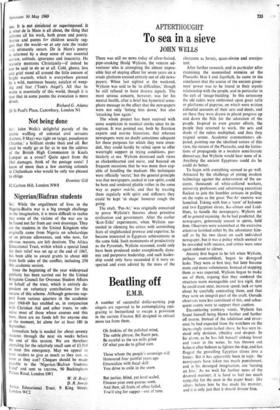To sea in a sieve
AFTERTHOUGHT JOHN WELLS
There was still no news today of silver-haired, pipe-smoking Hrald Wylison, the veteran ad- venturer who is attempting the almost impos- sible feat of staying afloat for seven years on a crude platform created entirely out of old news- papers. When last sighted at the weekend, Wylison was said to be 'in difficulties,' though he still refused to hoist distress signals. The most serious concern, however, was for his mental health, after a brief but hysterical sema- phore message to the effect that the newspapers were not only 'letting him down,' but also 'attacking him again.'
The whole project has been received with some scepticism in nautical circles since its in- ception. It was pointed out, both by flotation experts and marine historians, that whereas newspapers were no doubt sometimes adequate for those purposes for, which they were inten- ded, they could hardly be relied upon to offer watertight support in trying conditions, par- ticularly at sea. Wylisiin dismissed such views as chickenhearted and naive, and boasted on frequent occasions that he was more than cap- able of handling the medium. His techniques were officially 'secret,' but the general principle was that newspapers, soaked in raw spirit, could be bent and rendered pliable rather in the same way as papier wield, and that by treating them regularly with spirit and stiffeners they could be kept 'in shape' however rough the going.
The craft, 'Pee-Ar,' was originally conceived to prove Wylisdn's theories about primitive civilisation and government. After the earlier `Kon-Triki' experiments, when Wylison suc- ceeded in silencing his critics with astonishing feats of singlehanded prowess and expertise, he became interested in Egyptian achievements in the same field. Such monuments of productivity as the Pyramids, Wylison reasoned, could only have been produced under exceptionally dyna- mic and purposive leadership, and such leader- ship could only have succeeded if it were re- spected and even adored by the mass of the electorate as heroic, quasi-divine and omnipo- tent.
After further research, and in particular after examining the mummified remains of the Pharaohs Mac I and Jayefkeh, he came to the conclusion that the source of the ancient gover- nors' power was to be found in their mystic relationship with the people, and in particular in the cult of 'image-building.' In this ceremony the old rulers were enthroned upon great rafts or platforms of papyrus, on which were written colourful accounts of their acts and deeds, and on these they were drawn in placid progress up and down the Nile for the adoration of the people. Inspired to even greater efforts, the people then returned to work, the acts and deeds of the rulers multiplied, and thus they reigned serene. Academic commentators ob- jected, pointing out the idealised nature of this view, the stature of the Pharaohs, and the limita- tions of propaganda in a modern semi-literate democracy, but Wylison would hear none of it. Anything the ancient Egyptians could do he could do better.
To begin with everything seemed to go well. Attracted by the challenge of pitting modern technology against the achievement of the an- cients, thousands of white-collared workers, university professors and advertising executives flocked to join the humbler artisans in pulling on the ropes as the great 'Pee-Ar' exercise was launched. Taking with him a 'crew' of baboons and two Egyptian slaves, Ka-ufman and Loid- Hues, to handle the newspapers, Wylisi3n set off to general rejoicing. As he had predicted, the newspapers, generously soused in spirits, held firm. Observers were astonished at the excessive attention lavished either by the adventurer him- self or by his two slaves on each individual newspaper, but it was a policy which seemed to be rewarded with success, and critics were once again reduced to silence.
Anxiety first began to be felt when Wylison, perhaps overconfident, began to disregard leaks. They were at first tiny, but later became more and more voluminous. Instead of stopping them as was expected, Wylisdn began to make use of them, arguing that they rendered the structure more manageable and less rigid, that he could even steer, increase speed, tack or turn about by carefully controlling them, and that they were an integral part of the craft. Outside observers were less convinced of this, and subse- quent events were to support their caution. Encountering contrary winds, WylisOn has found himself being blown farther and farther off course. Instead of the adulation and rever- ence he had expected from the watchers on the increasingly storm-lashed shore, he has seen in- stead only derision, ribaldry and despair. In his alarm, as he has felt himself sinking lower and lower in the water, he has thrown out baboon after baboon to lighten the ship, and has flogged the grovelling Egyptian slaves into a frenzy. But it has apparently been in vain : the newspapers have taken too much punishment, and in his deranged imagination, are 'turning on him.' As we wait for further news of the doomed mariner, it is hard to feel too much sympathy for the man in the paper boat : like others before him he has made his monster, and it is only just that it should devour him.


































 Previous page
Previous page